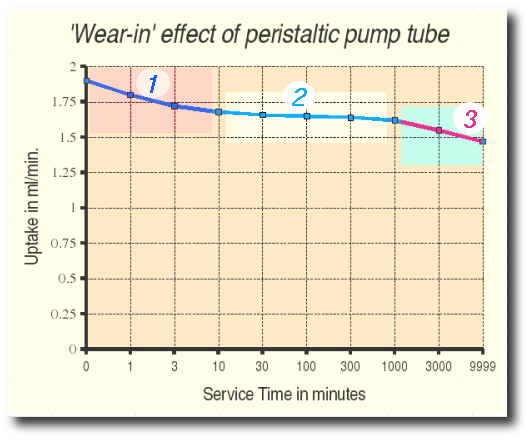|
|
What is the use of measuring sample flow when the sample is being pumped ? :
Firstly, pumps vary in accuracy : consider the peristaltic pump for example -
peristaltic pump tubes deliver liquid sample in a way that can change with time,
especially if tubes are strongly compressed.
- a typical result of flow measurement is shown below - only in region 2 is the flow reasonably constant.
- thus constant pump rotational speed is not always a guarantee of constant sample flow.
 Secondly, the sensitivity of most analytical instruments varies with sample flow in a non-linear way -
Secondly, the sensitivity of most analytical instruments varies with sample flow in a non-linear way -
 In region A, even small pump irregularities will show up markedly in the analytical signal ...
In region A, even small pump irregularities will show up markedly in the analytical signal ...
In region B, signal fluctuations from the pump are less noticeable, and ...
In the 'saturation region' C, pump fluctuations will have the least effect,
- but sample consumption will be at a maximum.
If sample uptake is measured by weight or volume differences over periods of minutes,
these fluctuations won't appear in long-term flow measurements.
The analytical signal could still be unstable however.
By making measurements in 'real-time' with a meter such as the
XENA ,
short-term flow changes will be recorded ... and noticed.
For quality assurance, place a XENA permanently between sample and instrument.
** An added benefit of these meters is that unwanted air bubbles will be noticed : these bubbles,
even though they are often very small, are a common cause of instability.
Contact EPOND for the real-time flow meter to suit your application : ICP-OES, ICP-MS, AAS or other technique
|
|
|
EPOND
Im Langhag 12
CH - 8307 Effretikon
Switzerland
tel.: +41 52 355 30 86 fax : +41 52 343 16 90
Email :
info @ e-pond. biz
|
|
|